***UPDATE January 1, 2018 ***
Archaeology magazine continues its 11-year-moratorium on Bosnian archaeology — an archaeology which includes the most astonishing archaeological discoveries of the new millennium: the estimated 34,000-year-old Bosnian Pyramid Complex in Visoko, Bosnia and the likely similarly ancient Megasphere in Zavidovici, Bosnia — while at the same time publishing archaeological non-news about a 106-year-old fruitcake found in Antarctica.
Desperate to distract us from the truth about humanity’s astonishing past on Earth, and in particular from the mountain of scientific evidence recently unearthed about an ancient civilization in Bosnia, in 2016 Archaeology magazine published another non-story, in a series of non-stories, about the discovery of artifacts associated with a quilter who was murdered in 1826. You heard it right. “On the evening of January 3, 1826, someone entered the Northumberland home of Joseph Hedley — known locally as ‘Joe the Quilter’ for his great skill with needle and thread — and brutally murdered the lonely old man.”

* * * *
“Megasphere”
September 24, 2016

Suad Keserovic excavates a giant stone ball in 2016 in Stone Spheres Park in Podubravlje village, near Zavidovici, Bosnia and Herzegovina.
It’s a mystery.

Archaeology magazine, the top magazine in the field of archaeology, has remained silent about a megasphere discovered in Bosnia.
Archaeology magazine, the most prestigious archaeology magazine in the world, has made no mention, in six months, of the March 2016 discovery of the most massive ancient stone sphere ever found.
Question: Why would the top magazine in the field of archaeology ignore what may be the most astonishing find of the decade, a mega-sphere found in Bosnia?
Another question: Why did the same magazine ignore what is certainly the find of the century (so far): the discovery of a prehistoric pyramid complex in Visoko, Bosnia?
Let’s keep these questions in mind as a Bosnian mega-sphere’s story unfolds.
A Megaspheric Discovery
The story of this mega-stone — the “megasphere,” as I call it — broke worldwide in April 2016, capturing the attention of major media all over the globe.
Major Media Mega-Coverage of the Megasphere:
The Telegraph (UK) April 11, 2016
Daily Mail (UK) April 7, 2016
The Mirror (UK) April 15, 2016
ABC News (US) April 14, 2016
Fox News (US) April 15, 2016
Yahoo News (US) April 14, 2016
Huffington Post (US edition) April 25, 2016
news.com (Australia) April 14, 2016
Yahoo (Canada) April 11, 2016
Russia Today (UK) April 14, 2016
International Business Times April 13, 2016
DNA (Daily News and Analysis) India April 12, 2016
EuroNews April 16, updated April 18, 2016

Dr. Sam Osmanagich, Ph.D., discoverer of the Bosnian Pyramids in Visoko, Bosnia and founder of Stone Spheres Park near Zavidovici, Bosnia, stands next to the megasphere, the largest ancient artificial stone ball excavated so far in Stone Spheres Park.
Oddly, the editors of Archaeology magazine completely ignored the megasphere’s discovery, making no mention of the astonishing find 1) in their print publication, 2) in their online publication, and 3) on their Facebook page.
In the last several years, Archaeology‘s Facebook page has run two “balls-topic” stories.

Two looted Roman sling stones returned to an Israeli museum. The “story” was posted on Archaeology magazine’s Facebook page on July 13, 2015.
These two stories may be the most ho-hum, dreary stories ever written in the annals of archaeology.
Archaeology‘s first balls-topic story is:
“Two looted Roman sling stones were anonymously returned to an Israeli museum. . . . A museum employee found the stones in a bag in the museum’s courtyard with a note that read, ‘These are two roman ballista balls from Gamla, from a residential quarter at the foot of the summit. I stole them in July 1995 and since then they have brought me nothing but trouble. Please, do not steal antiquities!'”
Archaeology‘s second “balls-topic” story in the last several years, a micro-story about micro-balls, is about musket balls:
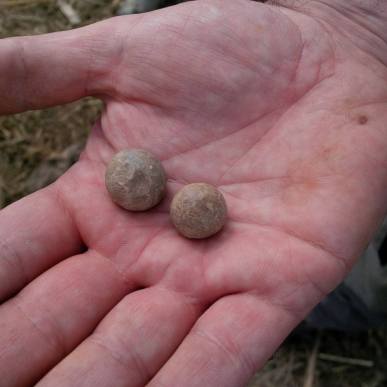
Unfired musket balls, allegedly from the Battle of Waterloo, a micro-story run by Archaeology magazine’s Facebook page. But the story of the most massive stone ball in the world being found in Bosnia, a mega-story about a mega-ball, was ignored by Archaeology magazine’s Facebook page and by both its online and its print publication.
“In Belgium, archaeologists have unearthed musket balls that might be from some of the first shots fired in the Battle of Waterloo.”
Archaeology magazine’s micro-articles about alleged Roman “sling stones” and Waterloo musket balls do not challenge or change anything we know about human history. Yet these two stories were the “balls stories” of choice for editors at Archaeology magazine over the last several years.
Archaeology‘s online publication reproduced and expanded the Facebook “sling stones” story and faithfully gave their readers a “musket balls” micro-story, though the online story was set in Massachusetts.
Instead of running a story about the most massive stone sphere ever discovered on the planet, the existence of which substantially challenges our understanding of human history, Archaeology magazine was happy to serve its readers pebble fare, scientific pabulum, thin orthodoxical wafers.
The Archaeological Orthodoxy: Gatekeepers of Archaeological Information
Who are the gatekeepers of archaeological information in the 21st century?
What are the names of the people at Archaeology magazine, who, for instance, in the spring of 2016, endeavored (and failed) to excise from archaeological history a 37-ton sphere? What is their education? What is their training? What is their aim? What, dare we ask, is their agenda?

Archaeology magazine Editor-in-Chief Claudia Valentino, with a degree in Magazine Journalism
Let’s look at the Top Four executives and editors at Archaeology magazine.
1) Editor-in-Chief Claudia Valentino. Ms. Valentino’s archaeology background is nonexistent. She holds a B.A. in Magazine Journalism from New York University.
What has been Ms. Valentino’s performance at the helm of this prestigious magazine? Ms. Valentino has ignored communication about Bosnian archaeology for four years. Specifically, she has steadfastly failed to respond to emails regarding new findings in Bosnian archaeology, since January 5, 2013.
What does Editor-in-Chief Claudia Valentino believe is more important than an ancient megasphere (and prehistoric megalithic pyramids and other structures) in Bosnia? Her magazine’s annual Top 10 Discoveries include “Colonial Cannibalism” (2013), and “World’s Oldest Pretzels” (2015).

Archaeology magazine Executive Editor Jarrett A. Lobell, with a BA (?) in Classics, Archaeology; no photo available on the entire public internet (?). Mr. Lobell publishes occasional articles on the ancient history of Greece, Crete, and other cultures. One recent article Mr. Lobell penned is: “Pompeii’s Dead Reimagined,” which is about an artist bizarrely recreating the dead people of Pompeii, “interpretations” of human suffering while being smothered to death and/or burned alive by hot ash.
2) Archaeology magazine Executive Editor Jarrett A. Lobell has a BA in Classics, Archaeology. Mr. Lobell publishes occasional articles like “Medieval Fashion Statement.” He writes: “There are numerous medieval written sources that describe bras as ‘breastbags,’ but until this discovery no one had any idea what these garments looked like. . . . The discovery will enable archaeologists . . . to learn more about tailoring by women.”

Lace-decorated linen bra, circa 1390 A.D.

Archaeology magazine Senior Editor Daniel Weiss, with a degree in Journalism; previously editor at Pharmacy Times (?)
3) Archaeology magazine Senior Editor Daniel Weiss has a degree in Journalism and experience as editor at Pharmacy Times. Mr. Weiss’s archaeological education is zero. Two of Mr. Weiss’s recent articles are “Heart Attack of the Mummies,” which states that 50-year-old Ötzi the Iceman might have had a heart attack if he had lived to age 80 (uh, what?), and “Memo to science nerds: Learn improv,” which conjectures that improv class helps science presenters be more “vivid and expressive.”
4) Finally, we come to the mysterious Peter Herdrich.
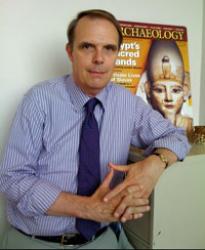
Archaeology magazine publisher Peter Herdrich, CEO at AIA (Archaeological Institute of America), unknown studies at Colombia University with graduate work (degree?) in Arts Administration.
Peter Herdrich is the publisher of Archaeology magazine. For many years, Mr. Herdrich was CEO at AIA (Archaeological Institute of America). How he obtained this position with his educational background is unknown. Mr. Herdrich studied at Colombia University but did not complete his studies. He studied at the Johannes Gutenberg-Universität in Germany but received no publicly available certificate or degree. Peter did graduate work at the School of the Arts at Columbia University (in Arts Administration) but again did not complete his studies.
Peter Herdrich’s publicly available, though not easily discoverable, CV is here. Mr. Herdrich’s current LinkedIn profile photo is below.

Archaeology magazine publisher Peter Herdrich biographical information: “Before moving into the not-for-profit world, Peter enjoyed long success in commercial television, primarily in news programming. He worked as a producer and writer at ABC, CBS Television Distribution, Disney, Fox, and NBC. . . . After finishing his undergraduate work at Columbia University (degree ?) and studying at the Johannes Gutenberg-Universität in Mainz, Germany (degree ?), Peter did graduate work at the School of the Arts at Columbia University in arts administration (degree?).”
As we have seen, only one of the four persons mentioned above has a degree in archaeology. Although obviously a university degree assures us of nothing, it is strange that persons without any education in archaeology have three of the top spots at this prestigious publication.
Question: Why is Peter Herdrich, whose experience is in commercial television production, in charge of publishing a magazine about archaeology?
Question: Why is Jarrett A. Lobell, who has only a B.A. in archaeology, Executive Editor at Archaeology magazine?
Question: Why is Claudia Valentino, whose education and experience has no relation to archaeology, Editor-in-Chief at Archaeology magazine?
Question: Why is Daniel Weiss, whose education and experience has no relation to archaeology, Senior Editor at Archaeology magazine?
Why are these four persons running the most prestigious archaeology magazine in the world?
A Bosnian Megasphere
Did you know that a giant stone sphere, the most massive ancient artificial stone sphere ever found, was discovered earlier this year in a country called Bosnia and Herzegovina?

Ancient history enthusiast Shawn Rateau stands by the megasphere, a giant artificially created stone sphere excavated in 2016 in Stone Spheres Park in Podubravlje, Bosnia. (Photo taken September 18, 2016 by Christoffer Kindmark.)
You wouldn’t know this fact if Archaeology magazine were your only source of information about archaeological finds on this planet. (More later about Archaeology magazine’s bizarre 10-year moratorium on Bosnian archaeology.)
Fortunately, although Archaeology magazine attempted to bury the discovery of the Bosnian megasphere under a mountain of silence, mega-news outlet Russia Today made a big deal about the Bosnian discovery.
RT sent their own people to a creek strewn with ancient stone spheres in a sleepy village called Podubravlje, Bosnia.
In fact, it was here in Podubravlje that, years earlier, Dr. Sam Osmanagich established Stone Spheres Park. Yes it’s true: Many ancient artificial stone spheres had already been found in the Zavidovici area before the ancient megasphere was discovered in 2016 (as can be seen in this video, “Trek to Stone Spheres Park in Zavidovici, Bosnia, June 21, 2015”).
Astonishingly, 80 stone spheres came out of a hill in Podubravlje in a rainstorm in 1936. Forty of the stone spheres floated down the creek to the River Bosna and disappeared during the original rainstorm in 1936. Today, only 18 stone spheres (some whole, some broken) remain in Stone Spheres Park.

Dr. Sam Osmanagich, Ph.D., founder of Stone Spheres Park in Podubravlje, Bosnia, talks with Field Archaeologist Anela Podrug (right) and a visitor (left) on a visit to the park on June 21, 2015. (Photo by Jock Doubleday.)

Dr. Sam Osmanagich, Ph.D., founder of Stone Spheres Park in Podubravlje, Bosnia, waits for visitors to assemble for a short lecture about the stone spheres on June 21, 2015. Less than a year later, in early 2016, excavation on the megasphere (not pictured here) would begin. (Photo by Jock Doubleday.)

Many of the spheres in Stone Spheres Park were deliberately broken open by gold seekers in the 1960s. No gold was found. Pictured are volunteers for Archaeological Park Foundation. More photos of Archaeological Park Foundation volunteers can be found here. (Photo by Jock Doubleday.)

A visitor reaches down to touch a partially buried stone sphere in Stone Spheres Park, June 21, 2015. (Photo by Jock Doubleday.)

Ancient artificially created stone sphere lies in dappled sunlight in Stone Spheres Park. (Photo taken September 18, 2016, by Shawn Rateau.)

Ancient artificial stone spheres line the creek below a hill out of which they rolled during a rainstorm in 1936. This section of the creek is part of Stone Spheres Park in Bosnia. (Photo by Shawn Rateau, September 18, 2016.)
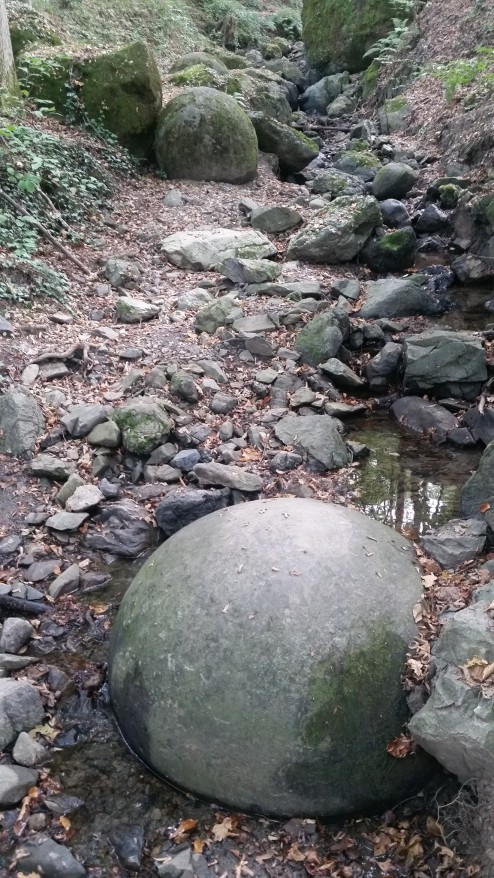
A stone sphere (not the megasphere), one of many ancient artificial stone spheres lining the creek below a hill out of which the spheres rolled during a rainstorm in 1936. The creek is part of Stone Spheres Park in Bosnia. (Photo by Shawn Rateau, September 18, 2016.)
The remaining 18 spheres (some pictured to the left and above), whole or broken, are undaunted survivors of extraordinary vandalism that occurred in the 1960s, when rumors that the spheres contained gold inspired Bosnian natives to begin taking sledge-hammers to the ancient stone balls — and/or to drill into the stone spheres and use dynamite to break them apart. No gold was found in the Bosnian stone spheres or in any of the stone spheres of Costa Rica — or in any other stone spheres across the globe in which it was presumed gold was hidden. Eventually, gold-seekers’ vandalism stopped worldwide.
Interestingly, the newly unearthed megasphere was actually discovered, in part, many years ago. According to an email sent to me by Dr. Osmanagich on September 1, 2016:
“Part of the stone ball [megasphere] was sticking out (approx. 50 cm radius [= 20 inch radius = 40 inch diameter = an area a little over 3 feet in diameter]) for the longest time. Only beginning of March [2016] two local men started clearing. They informed me at the very beginning so I suggested to keep working until my first visit in March.” Because no one knew how big the megasphere was, excavation had not been not pursued.

Suad Keserovic excavates the megasphere in Stone Spheres Park in Podubravlje village, near Zavidovici, Bosnia and Herzegovina.
Why did Russia Today need to come to the rescue of archaeological science in the case of a gigantic stone sphere found in the Balkans? It’s a good question, and we’ll be pursuing that question later in the article. But whatever the reason(s) for Archaeology magazine’s disinterest, Russia Today was kind enough, and smart enough, to immediately fill the profound scientific vacuum created by Archaeology magazine’s inaction.
Russia Today wrote, plainly, lucidly, on April 14, 2016: “This may be the largest and oldest sphere carved by human hands in Europe. Its origins are still a mystery . . . The stone sphere has a diametre of around 10 feet and an estimated weight of 70,000 pounds. Hundreds of tourists from around the world have already descended onto the forest near the town of Zavidovici, in Bosnia and Herzegovina, to see the sphere.” Russia Today also made a real-time video of the continuing excavation of the sphere:
Russia Today made one understandable error in its text. RT wrote that the megasphere was “carved by human hands.” Although some stone spheres around the world may have been carved or sculpted, as opposed to molded, we know from scientific analysis that spheres in Stone Spheres Park similar to (though smaller than), and in the near vicinity of, the recently discovered megasphere were molded, not carved.
What Are the Bosnian Stone Spheres Made Of?
As Dr. Sam Osmanagich, Ph.D., told a group of visitors to Stone Spheres Park on June 21, 2015:

Dr. Sam Osmanagich waits patiently for tourists to gather for a short lecture about the history of the stone balls in Stone Spheres Park, June 21, 2015 — nine months before the discovery of the megasphere. (Photo by Jock Doubleday.)
“We are the first . . . who actually analyzed the stone balls. We took traces from four of the stone balls, and one [sample] from the natural stone material. We did chemical and physical analysis. This is what we found out. Nine elements are exactly the same in the case of the stone balls and natural stone. And then one element only the natural stone has: SiO2 silicon dioxide. The stone balls don’t have it. They have two elements instead. One is manganese [Mn]. Manganese we use today to give the hardness to the material. And the second one is calcium carbonate [CaCO3], a binder. So, our conclusion: The builders of the stone balls were using natural stone, then melting it, adding the additives, to get the extreme hardness, and then pouring into the molds to get this spherical shape. And when they got dry, they got very hard and solid.”
– Dr. Semir Osmanagich, Bosnian Stone Spheres Park, Zavidovici, Bosnia, June 21, 2015
How Heavy Is the Bosnian Megasphere?
The Bosnian megasphere, an ancient stone ball found in Stone Spheres Park, has not been put on a scale, for reasons that are obvious. The stone is too heavy to lift by conventional and financially affordable means, and therefore the weight of this mega-stone must be deduced from its 1) size and 2) composition.
Interestingly, the Bosnian megasphere has a higher concentration of iron than the other stone spheres in the near vicinity in Stone Spheres Park. This higher iron concentration makes it, among other things, heavier. Why did the ancients want to make the largest sphere (so far found) in the vicinity the most iron-rich and therefore the heaviest? Unknown.
Laboratory chemical analysis was performed in September 2016 on two samples taken from the megasphere.
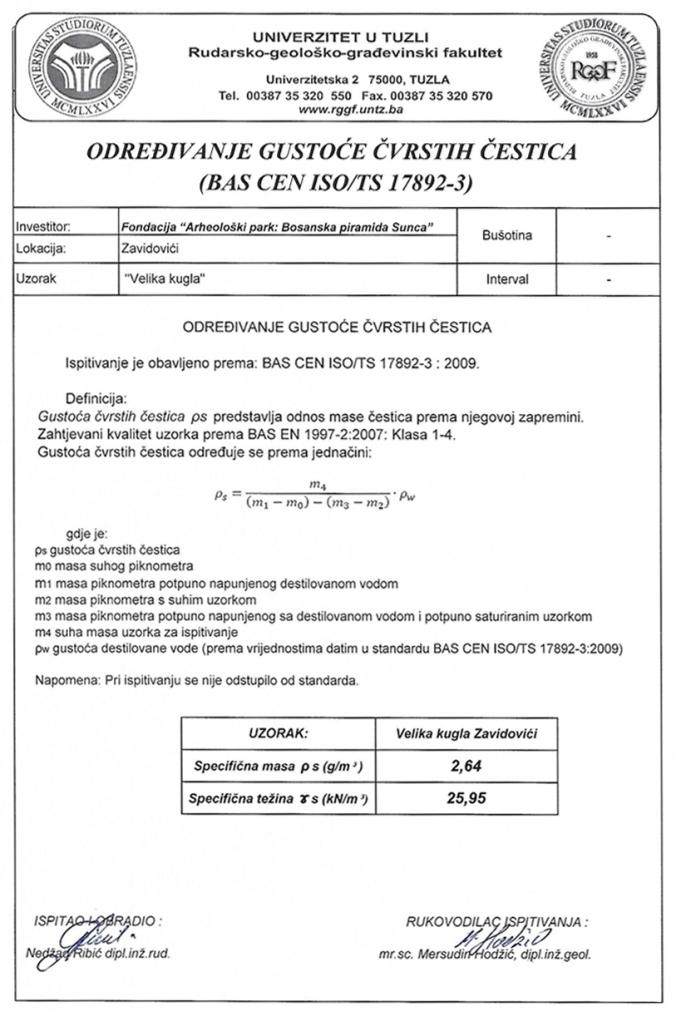
Certificate of laboratory analysis of the megasphere, courtesy of the University of Tuzla, Bosnia.
The Faculty of Mining, Construction and Geology at the University of Tuzla in Bosnia conducted the analysis. Master of Geology Mersudin Hodzic signed a statement in which he determined that the megasphere’s particle density (the ratio of particle mass to volume) is 2.64 grams / m3 (per cubic meter).
The weight of the megasphere, in kilograms, can be determined by multiplying particle density, or “specific gravity” (= 2.64 grams / m3) times volume (= 14.14 m3).
The weight of the megasphere found in Podubravlje is therefore an estimated 37.33 metric tons. (One metric ton = 1,000 kilograms.)
This estimated weight makes the megasphere the most massive stone ball ever found on Earth.
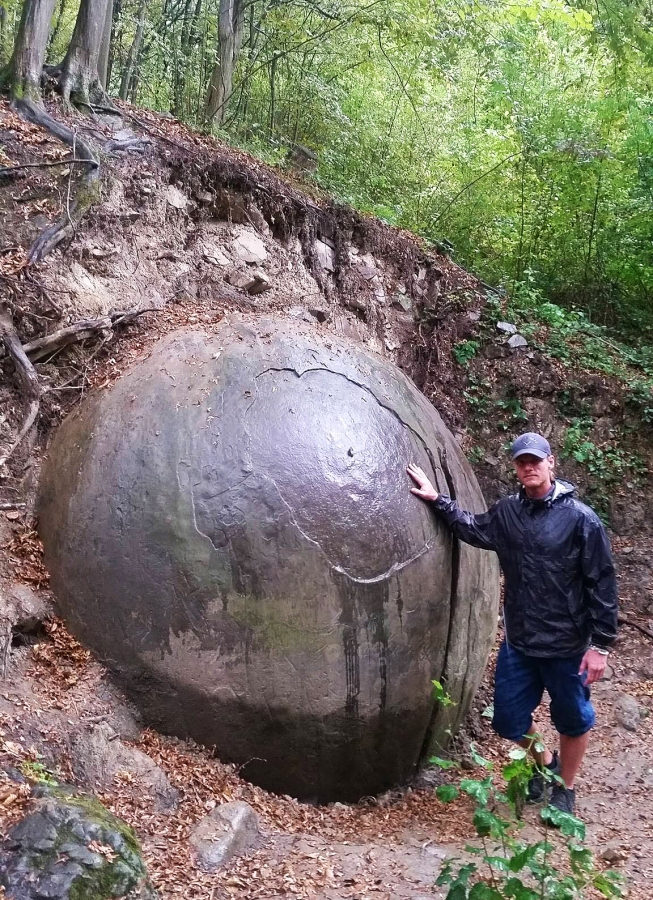
Ancient history enthusiast Shawn Rateau stands by the megasphere, at 37.33 metric tons the most massive stone of its kind yet discovered on planet earth, a giant artificially created (molded) ancient stone sphere partially excavated in 2016 in Stone Spheres Park in Podubravlje, Bosnia. (Photo by Christoffer Kindmark.)
As a comparison, we can look at the weight of other ancient stone balls found around the planet. The largest stone balls in Costa Rica (made out of a granodiorite, a mineral composite that reaches a 6 on the hardness scale) reach a top weight of 16 tons (article in Spanish). In western Mexico, near a town called Ahualulco, volcanic stone balls reach a weight of 35 tons, according to official on-site information.
Visiting Stone Spheres Park near Zavidovici, Bosnia
Question: How often does Dr. Sam Osmanagich personally take groups by luxury tour bus from the Sarajevo starting point to see Stone Spheres Park?
Answer: Dr. Osmanagich takes three groups per year, with 50 to 70 people in each group.
Question: What was the total number of Archaeological Park Foundation bus trips made from Saravejo in 2015 and 2016, with or without Dr. Osmanagich as tour guide?
Answer: Fifteen trips in 2015, and nine trips so far in 2016.
Question: Will the trip to Stone Spheres Park continue to be part of the Volunteering with Expeditions package in 2017?
Answer: Yes, it’s part of the Adventure package.
Question: How much does it cost a regular tourist (non-volunteer) to take the Stone Spheres Park tour by bus from Sarajevo?
Answer: Twenty-five euros.
A Bosnian Moratorium
If a giant ancient alien spaceship were discovered buried in the šuma (forests) of Bosnia, would Archaeology magazine cover the story?
Probably not.
Archaeology magazine has had a bizarre, indeed chilling, moratorium on Bosnian archaeology beginning a little more than one year after Dr. Sam Osmanagich discovered ancient pyramids in Visoko, Bosnia.
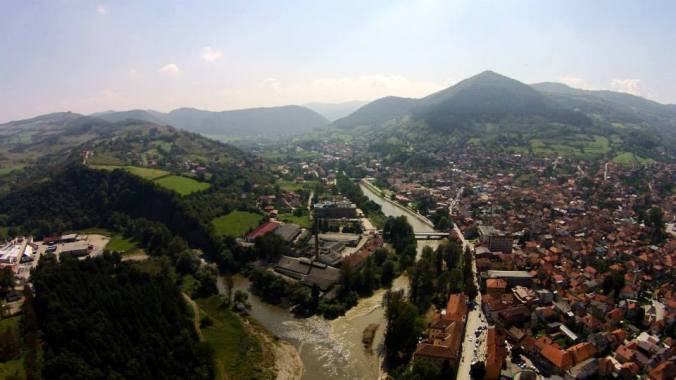
Bird’s-eye view photos of the Bosnian Valley of the Pyramids taken from a DJI Phantom quadcopter (aka microlight drone) by Andre de Smet, September 9, 2014.
Could there be some ideological (or other) agenda on the part of Archaeology magazine that we’re not aware of?
If you visit Archaeology magazine’s official site, http://www.archaeology.org/ and type “bosnia” into the Search box, your results will include Bosnia-related articles only from 2005 and 2006 — all of which stridently and vociferously deny the possibility of the existence of pyramids in Bosnia. (One can also perform a Google search for “archaeology magazine” bosnia.)
Please note that no one at Archaeology magazine has ever published a statement to the effect of, “Further excavation in Visoko needs to be done for scientists to know the truth about the structures in Visoko, Bosnia.” Instead, Archaeology magazine’s reaction was 1) immediate and 2) negative. Should a science magazine declare an absolute negative before significant excavation has been performed?

Excavated inclined structural stone terrace on the Bosnian Pyramid of the Moon. (Photo taken by Jock Doubleday on December 4, 2014. More photos from the Bosnian Pyramid of the Moon here.)
The only mention by Archaeology magazine of Bosnian archaeology after 2006 is a two-line mention in October 2008: “Businessman Semir Osmanagic continues to dig up Visoko, Bosnia and Herzegovina, in search of pyramids, ‘despite ridicule.’ University of Sarajevo archaeologist Enver Imamovic likens Osmanagic’s project to ‘letting me . . . perform surgery.'”
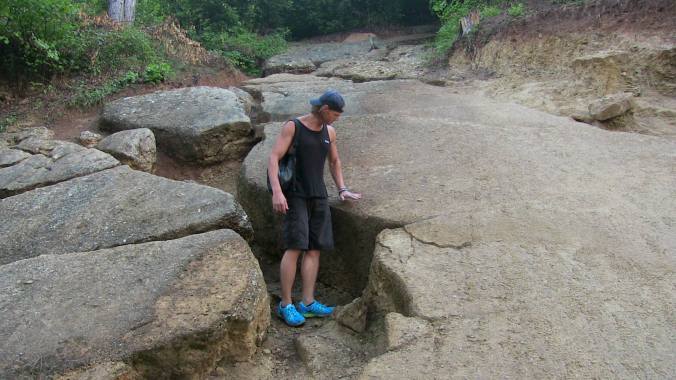
Shawn Rateau examines an ancient artificial construction concrete slab excavated by volunteers on the Bosnian Pyramid of the Sun in the Bosnian Pyramid Complex. (Photo taken by Jock Doubleday in Visoko, Bosnia on August 7, 2015. More photos here.)
In 7 years of Facebook postings, Archaeology magazine has failed to mention Bosnia once. (Neighboring Croatia has six mentions for four separate articles.)

Archaeology magazine’s Facebook page hasn’t mentioned Bosnia once in seven years.
A study of eleven years of Archaeology magazine articles allows us to conclude that Archaeology magazine editors, specifically Editor-in-Chief Claudia Valentino and Executive Editor Jarrett A. Lobell, perhaps at the behest of unknown persons, have attempted (and, thankfully, failed) to keep the lid on the biggest archaeological discovery of the 21st century: the discovery of gargantuan ancient pyramids and other structures in Bosnia.
It cannot be asserted that Archaeology magazine editors have not been aware of the continuous stream of scientific information emerging from the excavation and study of the Bosnian Pyramid Complex since mid-2005. On October 16, 2011, I emailed a detailed letter to the editor of Archaeology, the full text of which is reproduced here (in a blog titled, “Letter to the Editor of Archaeology Magazine”).
For ten years, Archaeology magazine has ignored not only Bosnian pyramid science but all archaeological discoveries from the country of Bosnia. This astonishing fact — the fact of deliberate silence on the part of the most prestigious print publication representative of mainstream academic archaeology — speaks volumes.

Archaeological Park Foundation volunteers help to excavate the megasphere, the most massive stone of its kind ever discovered, an ancient artificial stone sphere located in Stone Spheres Park in Central Bosnia, September 2016.
A Rejuvenating Science Vs. a Moribund Silence
While the Bosnian megasphere continues to be unearthed and all the ancient spheres in Stone Spheres Park studied — the science surrounding these mysterious objects continually refreshed, replenished, revitalized — Archaeology magazine’s moratorium on Bosnian archaeology gets older, frailer, more rigid, unquestionably morbid.
The halls of archaeological academia have had a dank smell of death about them for decades — while independent researchers not tethered to universities have gone out into the field and made astonishing discovery after astonishing discovery after astonishing discovery.
Around the world, the dry offerings of mainstream archaeology — thin, tasteless orthodoxical wafers — slowly become staler and staler, until one day it will be impossible for anyone of sane mind to even consider consuming them.

Tourists meditate on an ancient stone ball in Stone Spheres Park near Zavidovici, Bosnia, June 21, 2015. (Photo by Jock Doubleday.)
For daily updates on the Bosnian Pyramid Complex, ancient history, and
the newest science of our planet, our solar system, and our universe,
please visit the Facebook page I administer:
https://www.facebook.com/SemirOsmanagich/

Bosnian Pyramids enthusiast Vesna Anastasia Bozovic feels the energetic influence of an ancient stone sphere in Stone Spheres Park near Zavidovici, Bosnia, September 2013.

beautiful place…amazing energy and peace
LikeLike
From the article’s author: One needs an intelligent hand to replace silicon dioxide with a hardening agent and a binder. No one knows who made these spheres, but they are confirmed to be artificial constructions, not natural creations.
Laboratory analysis of similar stone spheres found in the vicinity of the megasphere concluded that the material was slightly different from that of the surrounding stones. The stone spheres had had a hardening agent added (manganese) and a binding agent added (calcium carbonate). Interestingly, the megasphere has a higher concentration of iron than the other spheres in the vicinity in Stone Spheres Park.
“We are the first one who actually analyzed the stone balls. We took traces from four of the stone balls, and one [sample] from the natural stone material. We did chemical and physical analysis. This is what we found out. Nine elements are exactly the same in the case of the stone balls and natural stone. And then one element only the natural stone has: SiO2 silicon dioxide. The stone balls don’t have it. They have two elements instead. One is Manganese [Mn]. Manganese we use today to give the hardness to the material. And the second one is calcium carbonate [CaCO3], a binder. So, our conclusion: The builders of the stone balls were using natural stone, then melting it, adding the additives, to get the extreme hardness, and then pouring into the molds to get this spherical shape. And when they got dry, they got very hard and solid.”
– Dr. Semir Osmanagich, Bosnian Stone Spheres Park, Zavidovici, Bosnia, June 21, 2015
http://anamericaninbosnia.blogspot.hr/2015/06/trek-to-stone-spheres-park-in.html
Therefore, we are looking at prehistoric archaeological finds, not geologic accidents.
Sincerely,
Jock Doubleday
Author, “The Mysterious Anti-Scientific Agenda of Robert Schoch – Part 1: The Bosnian Pyramid Complex”
http://anamericaninbosnia.blogspot.ba/2013/03/the-mysterious-anti-scientific-agenda_455.html
Part 1
“The Mysterious Anti-Scientific Agenda of Robert Schoch: Part 1 – The Bosnian Pyramid Complex”
http://anamericaninbosnia.blogspot.rs/2013/03/the-mysterious-anti-scientific-agenda_455.html
Part 2
“The Mysterious Anti-Scientific Agenda of Robert Schoch: Part 2 – The Yonaguni Monument 与那国記念碑”
http://anamericaninbosnia.blogspot.com/2013/02/the-mysterious-anti-scientific-agenda.html
Part 3
“Witchcraft Cartography and Clairvoyant Archaeology: A Review of Robert M. Schoch’s ‘Voices of the Rocks: A Scientist Looks at Catastrophes and Ancient Civilizations'”
http://anamericaninbosnia.blogspot.com/2013/03/witchcraft-cartography-and-clairvoyant.html
LikeLike
All of the stone spheres found in Stone Spheres Park in Zavidovici are composed of artificial sandstone – which is to say, sandstone that has been melted and then had extra elements added (see excerpt below) before being formed into spheres.
However, this new larger stone sphere has “high content of iron” – and its chemical makeup is not fully known – according to Dr. Sam Osmanagich on March 24, 2016. Laboratory analysis will be performed on this new stone and results published as soon as possible
Below is an excerpt from a talk by Dr. Sam Osmanagich at Stone Spheres Park in 2015 in which he discusses the chemical makeup of stone spheres found previously.
Dr. Sam Osmanagich, Ph.D. (last year, June 21, 2015): “We did chemical and physical analysis. This is what we found out. Nine elements are exactly the same in the case of the stone balls and natural stone. And then one element only the natural stone has: SiO2 silicon dioxide. The stone balls don’t have it. They have two elements instead. One is Manganese [Mn]. Manganese we use today to give the hardness to the material. And the second one is calcium carbonate [CaCO3], a binder. So, our conclusion: The builders of the stone balls were using natural stone, then melting it, adding the additives, to get the extreme hardness, and then pouring into the molds to get this spherical shape. And when they got dry, they got very hard and solid.”
– Dr. Semir Osmanagich, Bosnian Stone Spheres Park, Zavidovici, Bosnia, June 21, 2015
http://anamericaninbosnia.blogspot.rs/2015/06/trek-to-stone-spheres-park-in.html
Now the question is, why is there a huge hill composed of stone balls that it took modern rainstorm deluges to reveal?
LikeLike
I LOVE your work on Bosnia spheres and pyramids. Don’t allow that FAKE magazine to hold you up. Do as you are….use social media
LikeLike
Thanks Patrick.
My page on ancient history and the newest science (“the electric universe”) is here:
https://www.facebook.com/SemirOsmanagich
And here’s my Youtube channel that I maintain for the Archaeological Park Foundation:
http://youtube.com/BosnianPyramids
“The world is an archeological dig, and the sky is a traffic jam.”
Jock
LikeLike